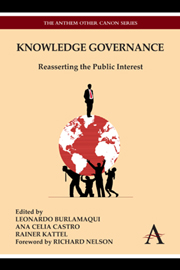Book contents
- Frontmatter
- Contents
- List of Abbreviations
- List of Tables and Figures
- Foreword
- Introduction
- Part I Knowledge Governance: Building a Framework
- Part II Innovation, Competition Policies and Intellectual Property: Institutional Fragmentation and the Case for Better Coordination
- 4 Where Do Innovations Come From? Transformations in the US Economy, 1970–2006
- 5 Antitrust and Intellectual Property: Conflicts and Convergences
- 6 The Politics of Pharmaceutical Patent Examination in Brazil
- Part III Going Forward: Towards a Knowledge Governance Research Agenda
4 - Where Do Innovations Come From? Transformations in the US Economy, 1970–2006
from Part II - Innovation, Competition Policies and Intellectual Property: Institutional Fragmentation and the Case for Better Coordination
Published online by Cambridge University Press: 05 April 2013
- Frontmatter
- Contents
- List of Abbreviations
- List of Tables and Figures
- Foreword
- Introduction
- Part I Knowledge Governance: Building a Framework
- Part II Innovation, Competition Policies and Intellectual Property: Institutional Fragmentation and the Case for Better Coordination
- 4 Where Do Innovations Come From? Transformations in the US Economy, 1970–2006
- 5 Antitrust and Intellectual Property: Conflicts and Convergences
- 6 The Politics of Pharmaceutical Patent Examination in Brazil
- Part III Going Forward: Towards a Knowledge Governance Research Agenda
Summary
Introduction
There is a growing international realization that nations that develop more effective national systems of innovation will have a significant advantage in the global economy. And that realization, in turn, has led to intense debates over which rules for governing intellectual property are most consistent with a strong innovation system. The problem, however, is that most of the empirical work on this question has focused on the analysis of data on patenting rates across countries and by different types of firms. But patent rates are a problematic proxy for effective innovation, and there is a danger that reliance on this proxy is producing a distorted understanding of the circumstances under which innovation occurs and the intellectual property regimes that might best facilitate such innovation.
This chapter brings a quite different data source to bear on understanding changes in the US innovation system over the last four decades. The data set is a sample of key innovations in the US economy drawn from an annual awards competition for innovative products organized by R&D Magazine. By looking not at patent data but at actual new products that are admired by prize juries, we hope to illuminate the changing sources of innovation in the US economy.
Reviewing the Literature
In The Coming of Post-Industrial Society, the late sociologist Daniel Bell provided the most systematic elaboration of the postindustrial concept. In his analysis, postindustrial change is driven by the systematic harnessing by both business and government of science and technology to expand and continuously update the production of goods and services.
- Type
- Chapter
- Information
- Knowledge GovernanceReasserting the Public Interest, pp. 81 - 104Publisher: Anthem PressPrint publication year: 2012
- 5
- Cited by

